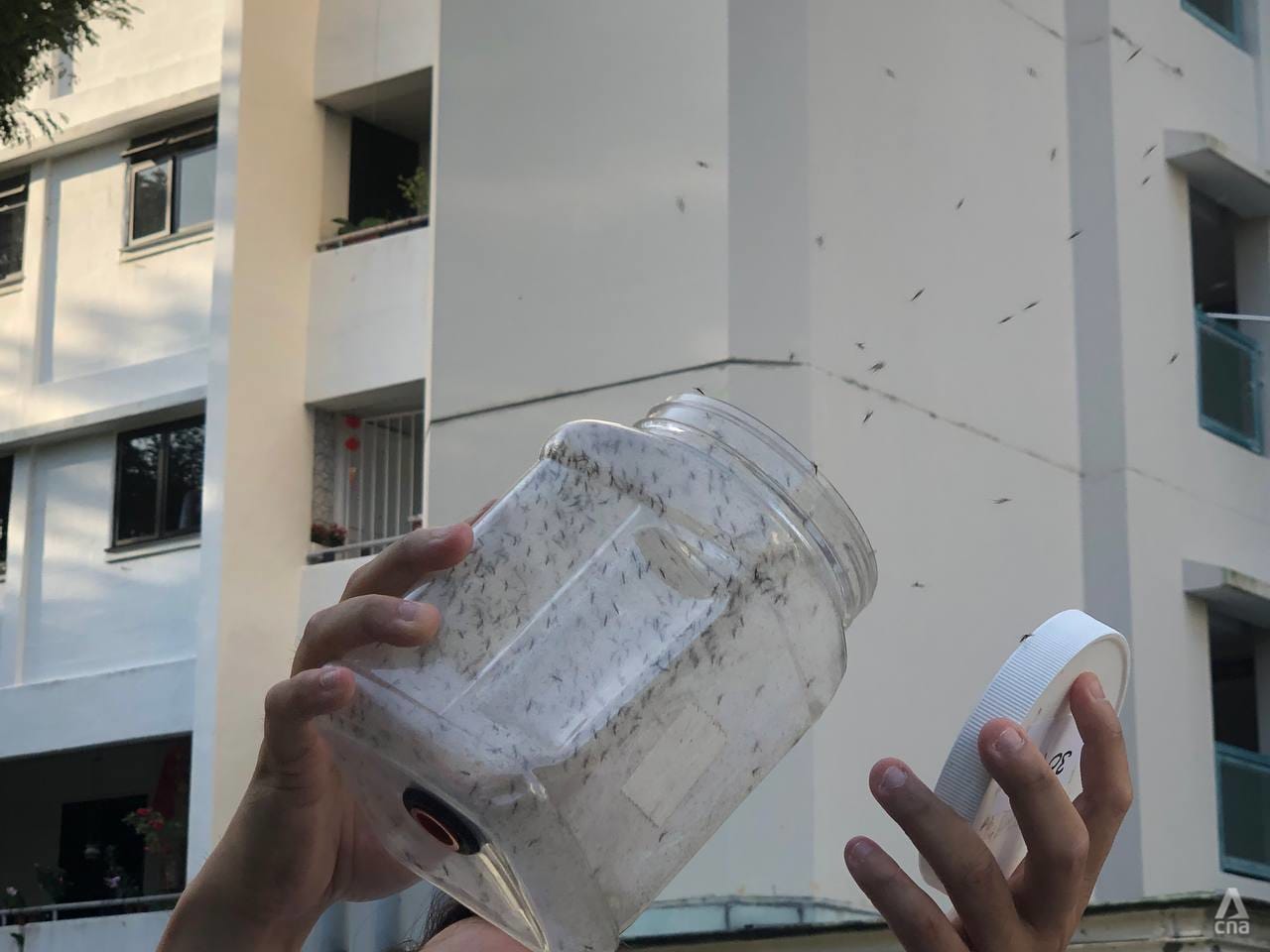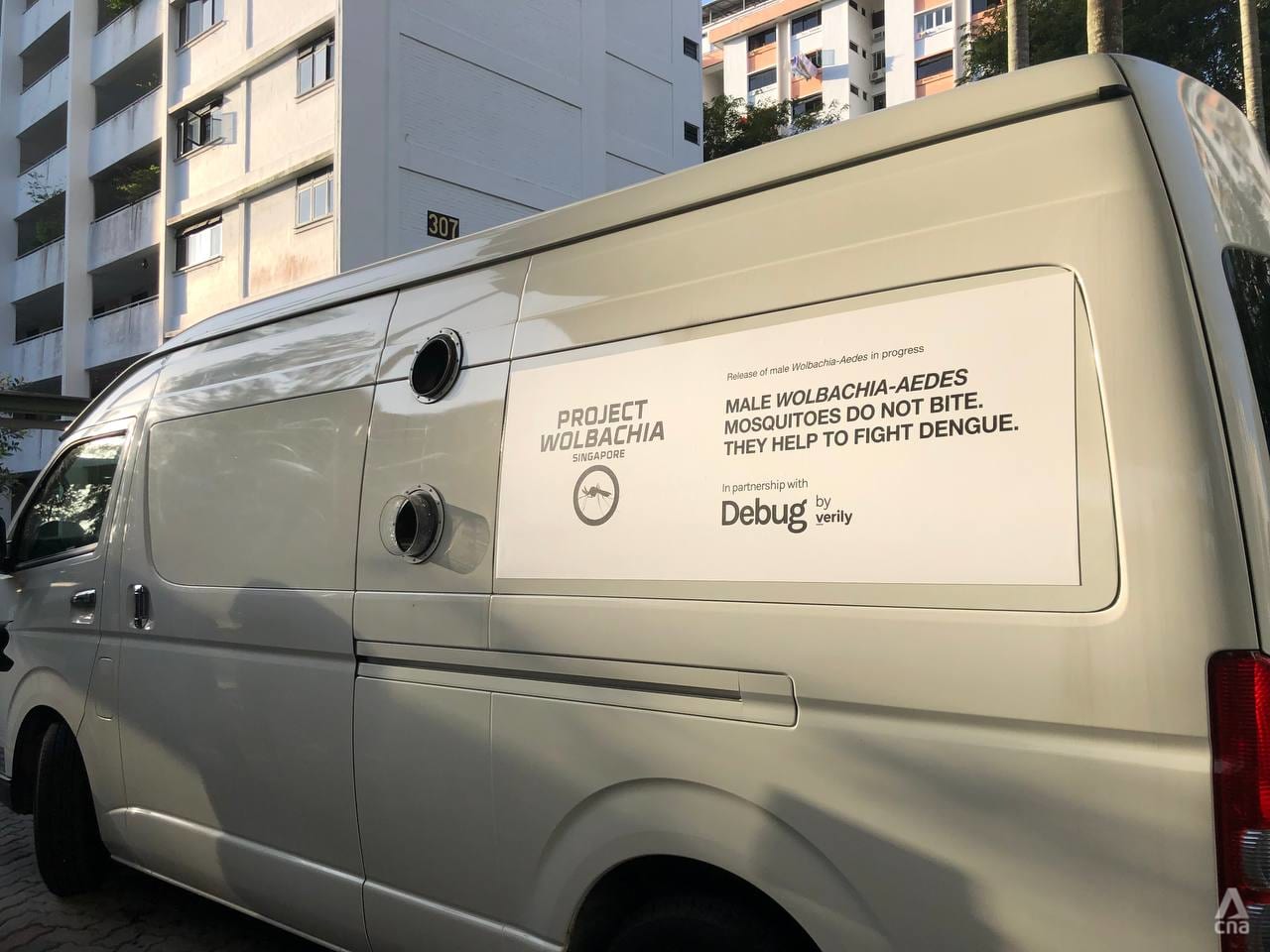Wolbachia mosquitoes released at Clementi site as part of project expansion to fight dengue
Wolbachia mosquitoes will be released at five sites by the first quarter of 2024, covering 480,000 households.

Ms Sim Ann, adviser to Holland-Bukit Timah grassroots organisation, releasing Wolbachia mosquitoes at a residential site in Clementi on Feb 20, 2024. (Photo: CNA/Natasha Ganesan)

This audio is generated by an AI tool.
SINGAPORE: About 350,000 male Wolbachia-carrying Aedes aegypti mosquitoes were released at a new Clementi site on Tuesday (Feb 20), as part of plans to expand Project Wolbachia to more areas in Singapore.
By the first quarter of this year, male Wolbachia-Aedes mosquitoes will be released at five residential sites in the south of Singapore, comprising both Housing and Development Board (HDB) and landed estates.
The five locations are Bukit Merah-Telok Blangah, Clementi-West Coast, Commonwealth, Holland and Marine Parade-Mountbatten. With this, Project Wolbachia will cover 480,000 households - up from 350,000 in 2023 - and representing an increase from 26 per cent to 35 per cent of households in Singapore.
The expansion will also see 11 million male Wolbachia-Aedes mosquitoes produced weekly - up from seven million in 2023, said the National Environment Agency (NEA).
The release of the mosquitoes comes less than a week after NEA urged "immediate action" to suppress Aedes mosquito numbers as dengue cases continue to increase.
“The steady rise in weekly dengue cases over the past ten weeks is a big concern, and is likely driven by intense disease transmission in areas with high Aedes mosquito population," the agency said on Feb 15.
The number of Aedes mosquito breeding habitats found in residences last month also doubled from January 2023.
Latest data from NEA's website showed that 2,969 dengue cases had been recorded in the first seven weeks of this year.
Speaking after the mosquito release, adviser to Holland-Bukit Timah grassroots organisation Ms Sim Ann said she welcomed the release of the Wolbachia mosquitoes in the Clementi-West Coast area.
“I'm very glad that we're now under the coverage of Project Wolbachia because we have seen that it has … some good effects in terms of reducing the overall population of Aedes aegypti mosquitoes and the risk of our residents catching dengue fever.”
Ms Sim acknowleged that the release of the mosquitoes is “not the answer to everything”.
“We still have to maintain vigilance. We will still need to do our part to prevent or minimise mosquito breeding.
“But we do believe that Project Wolbachia will make a difference to our anti-dengue efforts,” she added.


“NOT A SILVER BULLET”
A combination of van and manual releases is currently used at the Tampines and Marine Parade study sites and will be deployed at the five additional sites from the first quarter of 2024, said NEA on Tuesday.
The agency added that it plans to develop an additional source of supply of the Wolbachia-Aedes mosquitoes, on top of the current capacity, and will continue to engage the industry on the user and technical requirements for the additional capacity.
Under Project Wolbachia, male Aedes aegypti mosquitoes that carry the Wolbachia bacteria are released to mate with the female Aedes aegypti in an urban environment. The resulting eggs do not hatch.
The continued release is expected to reduce the urban Aedes aegypti mosquito population and lower the risk of dengue transmission over time.
Since the start of Project Wolbachia in 2016, NEA has observed “positive results” across study sites.
There has been more than 90 per cent reduction of the Aedes aegypti population in Bukit Batok, Choa Chu Kang, Tampines and Yishun, said the agency.
Data from 2019 to 2022 also indicated that residents living in areas with at least one year of releases are up to 77 per cent less likely to be infected with dengue, it added.
Preliminary data from the eight study sites under the multi-site field study launched in June 2022 also suggest reductions of more than 80 per cent in Aedes aegypti mosquito population.
NEA also highlighted that while the releases of male Wolbachia-Aedes mosquitoes will help reduce the Aedes aegypti mosquitoes and dengue risk, they "may not completely eliminate them".
“In the event of high dengue transmission or large dengue clusters within the study sites, dengue control operations will continue to be implemented,” said NEA.
“Wolbachia-Aedes suppression technology is not a silver bullet and is intended to complement, not replace source reduction efforts.”
Diminished community efforts to reduce mosquito breeding may negate the effect of the releases, and can lead to an increase in dengue cases, said the agency.
NEA added that it is “critical” to regularly practice the “B-L-O-C-K” steps so that "neighbourhoods and homes can be kept free of mosquitoes and dengue”:
- Break up hardened soil
- Lift and empty flowerpot plates
- Overturn pails and wipe their rims
- Change water in vases
- Keep roof gutters clear and place BTI insecticide inside

















